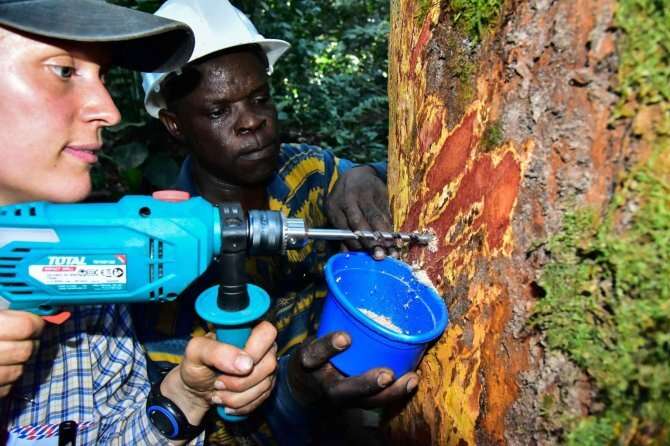This article has been reviewed according to Science X's editorial process and policies. Editors have highlighted the following attributes while ensuring the content's credibility:
fact-checked
peer-reviewed publication
trusted source
proofread
'Fingerprint' of wood can help fight illegal trade

The chemical composition of tropical timber used, for example, for bridges or in window frames, reveals where the trees were growing. This can be used to help trace timber origin and reduce illegal trade.
This is the main finding of large-scale collaborative research by Wageningen University & Research and their international partners. The study collected wood samples from nearly 1,000 timber trees from Central Africa and Borneo, and their chemical composition was analyzed. The team found that chemical fingerprints of wood revealed their origin at sub-national scales.
Illegal tropical timber trade
Illegal timber trade ranks among the most profitable wildlife crimes and false declaration of origin is one of the main types of timber fraud. Trading routes are often complex, with timber passing through multiple countries before arriving at its destination. This increases the risk of declarations Timber fraud is especially high in the tropics, with some countries in the Congo Basin estimated to have up to 90% illegally exported timber.
Recent legislation in the European Union demands timber traders to prove that their products are legally obtained and do not come from deforested areas. Laura Boeschoten, a Ph.D. candidate at Wageningen University & Research and lead author of the study published this week in Environmental Research Letters states, "This means that timber origin must be reported when products are brought to the European market. For example, when arriving at Rotterdam Harbor. Independent methods to verify timber origin will become crucial for the enforcement of this new law. Multi-element analysis, as applied in our research, could be an effective tool in achieving this."
The team analyzed the chemical composition of wood samples: their "fingerprints." Boeschoten said, "A large number of chemical elements were measured at once (such as magnesium and calcium) by using a mass spectrometer. As a next step, we used machine learning methods to relate the wood chemical composition to its geographic origin." Multi-element analysis has already been put into practice to verify the geographic origin of commodities such as asparagus, bananas, and tea, but this study is the first to apply it to timber.
Successful tracing at a sub-national level
The researchers found substantial variations in the wood elemental composition of three major timbers. "We were thrilled to see significant differences at small spatial scales, such as between locations only 50 km apart," says co-author Pieter Zuidema, a professor at Wageningen University & Research. "This is essential for tracing timber to a specific origin."
The international team studied Red Meranti—an Asian timber used for window framing—and the African timbers Azobe and Tali—used in waterworks. As a result of the strong regional variation in chemical fingerprints, samples could be traced back to their sub-national origin with 86%–98% accuracy in Central Africa and to the forest of origin with 88% accuracy in Borneo. Independently collected blind samples from Central Africa were correctly assigned for 70%–72% at a sub-national level.
More information: Laura E Boeschoten et al, A new method for the timber tracing toolbox: applying multi-element analysis to determine wood origin, Environmental Research Letters (2023). DOI: 10.1088/1748-9326/acc81b
Journal information: Environmental Research Letters
Provided by Wageningen University





















